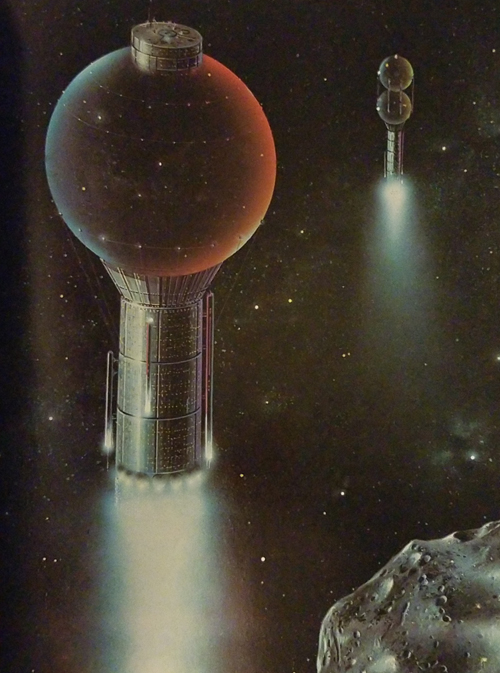Difference between revisions of "Galileo class (FASA)"
m |
m |
||
| (9 intermediate revisions by the same user not shown) | |||
| Line 1: | Line 1: | ||
| − | {{DISPLAYTITLE:''Galileo'' class}} | + | {{DISPLAYTITLE:''Galileo'' class (FASA)}} |
| − | + | {{ImageInfoBox2|name=''Galileo'' class|file=galileo_class-sfc.jpg|caption=''Galileo'' class ([[Star Trek: Spaceflight Chronology|SFC]])}} | |
| − | == | + | {{TableRow|title=Commissioned|data=[[2020s (FASA)#2028|2028]]}} |
| − | The ''Galileo'' class entered service in [[FASA | + | {{TableRow|title=Advertising|data={{AmazonLink2|asin=0671790897}}}} |
| − | + | |}</div> | |
| − | === | + | {{BannerFASA}} |
| − | + | The ''Galileo'' class entered service in [[2020s (FASA)#2028|2028]]. One of the most durable workhorses in spaceflight history, ''Galileo'' class ships were early fusion ships that could attain modest relativistic speeds (.2[[speed of light|c]]; later .35c) and began to take [[Humans (FASA)|humanity]] into interstellar space. In the [[2030s (FASA)|2030s]], the ''Galileo'' class was the primary ship class to the asteroid belt, and in the [[2040s (FASA)|2040s]], it was the most popular carrier to the outer planets. The ''Galileo'' class vessels were retired from service in [[2050s (FASA)#2052|2052]]. The ''Galileo'' class featured a complement of 98 personnel, including six officers and 92 enlisted crew members, and could be modified with multiple forward fuel spheres for extended missions. The ''Galileo'' class was the first Human vessel equipped with elementary interstellar celestial navigation.<ref name="SFC"/> | |
| − | + | {{InfoBox|float=left|name=Specifications}} | |
| − | ==References | + | {{TableRow|title=Length|data=300 [[meter|m]]}} |
| + | {{TableRow|title=Diameter|data=120.7 [[meter|m]]}} | ||
| + | {{TableRow|title=Mass|data={{bullet}} Empty: 500 million [[kilogram|kg]]<br/>{{bullet}} Loaded: 4.84 billion [[kilogram|kg]]}} | ||
| + | {{TableRow|title=Fuel Sphere|data=920,000 [[cubic meter|m³]]}} | ||
| + | {{TableRow|title=Crew Compartment|data={{bullet}} 6 Decks<br/>{{bullet}} Length: 40.8 [[meter|m]]<br/>{{bullet}} Diameter: 35.5 [[meter|m]]}} | ||
| + | {{TableRow|title=Cargo Volume|data=40,000 [[cubic meter|m³]]}} | ||
| + | {{TableRow|title=Forward Command Sensor Disc Diameter|data=35.5 [[meter|m]]}} | ||
| + | {{TableRow|title=Propulsion|data=4 Space Op Fusion Engines with 10 laser/electron fusion initiators per engine}} | ||
| + | {{TableRow|title=Fuel|data=Frozen [[deuterium]]}} | ||
| + | {{TableRow|title=Navigation|data=Interplanetary Triangulation/Elementary Celestial Navigation}} | ||
| + | {{TableRow|title=Communications|data={{bullet}} Encoded Particle Beam Telemetry<br/>{{bullet}} Exterior Crystal Communications Transceiver}} | ||
| + | {{TableRow|title=Computer|data=Intermediate Independent Thought Memory Scan}} | ||
| + | {{TableRow|title=Life Support|data={{bullet}} Gravity: 0.4 [[gravity|g]]<br/>{{bullet}} Atmosphere: 23% [[oxygen|O&sub2;]]; 10% humidity}} | ||
| + | {{TableRow|title=Range|data=12 years at standard ship's complement of 6}} | ||
| + | |}</div> | ||
| + | {{InfoBox|float=left|name=Performance}} | ||
| + | {{TableRow|title=Range|data={{bullet}} Standard: 800 million [[kilometer|km]] ([[Earth]] to asteroid belt)<br/>{{bullet}} Maximum: 10<sup>13</sup> [[kilometer|km]] (~1 [[light year]])}} | ||
| + | {{TableRow|title=Velocity|data={{bullet}} Cruising: 200 million [[kilometer|km]]/hr<br/>{{bullet}} Maximum: 375 million [[kilometer|km]]/hr}} | ||
| + | {{TableRow|title=Voyage Duration|data={{bullet}} Typical: 17.4 hr (asteroid belt)<br/>45 hr ([[Pluto]] Research Station)<br/>{{bullet}} Maximum: 2.3 years}} | ||
| + | {{TableRow|title=Acceleration|data={{bullet}} 0-1 million [[kilometer|km]]/hr: 3.55 hr<br/>{{bullet}} 1-100 million [[kilometer|km]]/hr: 2.85 hr<br/>{{bullet}} 2-3.5 million [[kilometer|km]]/hr: 3-10 hr}} | ||
| + | {{TableRow|title=Thrust|data=10 million [[kilogram|kg]] per fusion engine}} | ||
| + | |}</div> | ||
| + | {{ClassGalileo}} | ||
| + | {{References}} | ||
<references> | <references> | ||
| − | <ref name="SFC"> | + | <ref name="SFC">{{RefSFC}}</ref> |
</references> | </references> | ||
| − | |||
[[Category:Library]] | [[Category:Library]] | ||
[[Category:Ships & Vehicles]] | [[Category:Ships & Vehicles]] | ||
| + | [[Category:Ship Classes]] | ||
[[Category:UNSF Vessels]] | [[Category:UNSF Vessels]] | ||
| − | [[Category:Human]] | + | [[Category:Human Vessels]] |
[[Category:Books]] | [[Category:Books]] | ||
| − | + | [[Category:FASA Timeline]] | |
| − | |||
| − | [[Category:FASA | ||
| − | |||
Latest revision as of 10:14, 12 March 2021
The Galileo class entered service in 2028. One of the most durable workhorses in spaceflight history, Galileo class ships were early fusion ships that could attain modest relativistic speeds (.2c; later .35c) and began to take humanity into interstellar space. In the 2030s, the Galileo class was the primary ship class to the asteroid belt, and in the 2040s, it was the most popular carrier to the outer planets. The Galileo class vessels were retired from service in 2052. The Galileo class featured a complement of 98 personnel, including six officers and 92 enlisted crew members, and could be modified with multiple forward fuel spheres for extended missions. The Galileo class was the first Human vessel equipped with elementary interstellar celestial navigation.[1]
| Length | 300 m |
| Diameter | 120.7 m |
| Mass | • Empty: 500 million kg • Loaded: 4.84 billion kg |
| Fuel Sphere | 920,000 m³ |
| Crew Compartment | • 6 Decks • Length: 40.8 m • Diameter: 35.5 m |
| Cargo Volume | 40,000 m³ |
| Forward Command Sensor Disc Diameter | 35.5 m |
| Propulsion | 4 Space Op Fusion Engines with 10 laser/electron fusion initiators per engine |
| Fuel | Frozen deuterium |
| Navigation | Interplanetary Triangulation/Elementary Celestial Navigation |
| Communications | • Encoded Particle Beam Telemetry • Exterior Crystal Communications Transceiver |
| Computer | Intermediate Independent Thought Memory Scan |
| Life Support | • Gravity: 0.4 g • Atmosphere: 23% O&sub2;; 10% humidity |
| Range | 12 years at standard ship's complement of 6 |
| Range | • Standard: 800 million km (Earth to asteroid belt) • Maximum: 1013 km (~1 light year) |
| Velocity | • Cruising: 200 million km/hr • Maximum: 375 million km/hr |
| Voyage Duration | • Typical: 17.4 hr (asteroid belt) 45 hr (Pluto Research Station) • Maximum: 2.3 years |
| Acceleration | • 0-1 million km/hr: 3.55 hr • 1-100 million km/hr: 2.85 hr • 2-3.5 million km/hr: 3-10 hr |
| Thrust | 10 million kg per fusion engine |
Notes and References
- ↑ Goldstein, Stan et al (Authors). Spaceflight Chronology. Star Trek. Book. Wallaby Books. 1980.

